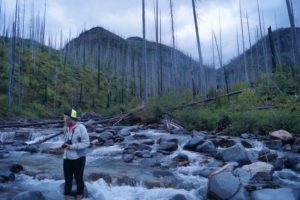Study Shows Decline in Wolf Population
In 1958, Durward Allen initiated the ecology study of the moose-wolves interactions on Isle Royale. This study, unlike many ecologies studies the last two-three years, has been going on for 50 plus years and plans to continue indefinitely.
Isle Royale is a unique study, not only because of the length of study, but also how it is naturally isolated from other species that could affect the population. On the island, there is only one predator of the moose, the wolf.
For ecologists seeing how the populations fluctuate in relation to each other has let them understand the importance of having balanced populations.
Over the years, the populations of Moose and wolves have fluctuated. When one population is low, ecologists who study the populations meticulously decided when to make introductions of what and how many. This changes the dynamic of the island and researchers can understand the relationship between the two populations, and their interactions with each other.
The wolf population is currently in grave danger on Isle Royale. According to the National Park service, the wolf population has reached just two wolves in the past five years. A natural recovery of the population seems highly unlikely.
In December 2016, the Park Service announced that they were planning to release 20-30 wolves on the island over the next three years, according to the Detroit Free Press.
The wolf population has decreased significantly in recent years, and this could mean an over population of moose coming in the future, if the wolves are not brought into balance of the moose population.
The decrease in the wolf population is due to many factors. In 2010 the wolf pack was up to 19 wolves, but since then the population has declined. One of the reasons for this is the lack of genetic variation and a high rate of inbreeding that has lead to a high death rate among the wolf pups.
According to isleroyale.org, another reason for the decline is that the last few winters have had above average temperatures. With these warmer temperatures the ice bridges that usually form from land to the island have not formed. This means that the wolves that usually cross the ice bridges and come to the island do not have a way to access the island and there is no natural migration of the wolf population.
With the lack of new wolves being introduced on the island, inbreeding is not uncommon. Inbreeding leads to genetic mutations in the current population. This could cause major problems for the future of the wolves on Isle Royale.
The National Park Service hopes to continue the study of the Moose-Wolf population interaction, and the reintroduction of wolves seems like the only solution to keeping this important ecological study going. They are currently in the process of drafting a plan for the reintroduction that would allow it to go smoothly and not shock the current ecosystem of the island.
























































